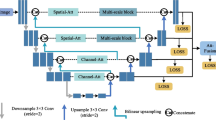Abstract
CNN-based methods have improved the performance of edge detection in recent years. While a common issue with the most recent methods is that there is a thickness problem in predicting the edge map, and when objects are small or have dense edges, the predicted edge lines are blurred. We know that multi-pooling reduces the resolution of features, and using a balanced cross-entropy loss function will also make the predicted edges thicker. In this paper, we propose a multi-scale feature hybrid network for edge detection to improve edge resolution. Multiple long and short residual connections are set to establish various information propagation pathways. We construct a feature enhancement unit in the up-sampling path of the network to obtain multi-scale features and fuse higher-resolution features. We demonstrate that residual connections in the network can overcome the class-imbalance training problem in edge samples. Moreover, we introduce a new biased cross-entropy loss function to accomplish the training of our network better, which adjusts the weights according to the ratio of edges and non-edges pixels. Compared to other methods, our network can predict clearer and sharper edges with more details. Evaluate the network on BSDS500 and NYUDv2, our method achieves ODS F-measure of 0.832 on the BSDS500 dataset and 0.768 on the NYUD dataset, best than current state-of-the-art results.





Similar content being viewed by others
References
Arbeláez, P., Maire, M., Fowlkes, C., Malik, J.: Contour detection and hierarchical image segmentation. IEEE Trans. Pattern Anal. Mach. Intell. 33(5), 898–916 (2011). https://doi.org/10.1109/TPAMI.2010.161
Chen, L., Papandreou, G., Kokkinos, I., Murphy, K., Yuille, A.L.: DeepLab: semantic image segmentation with deep convolutional nets, atrous convolution, and fully connected CRFs. IEEE Trans. Pattern Anal. Mach. Intell. 40(4), 834–848 (2018). https://doi.org/10.1109/TPAMI.2017.2699184
Silberman, N., Hoiem, D., Kohli, P., Fergus, R.: Indoor segmentation and support inference from RGBD images. In: 12th European Conference on Computer Vision, vol. 7576, no. 5, pp. 746–760 (2012)
Xie, S., Tu, Z.: Holistically-nested edge detection. In: IEEE International Conference on Computer Vision, Santiago, pp. 1395–1403 (2015). https://doi.org/10.1109/ICCV.2015.164
Liu, Y., Cheng, M., Hu, X., Wang, K., Bai, X.: Richer convolutional features for edge detection. In: 2017 IEEE Conference on Computer Vision and Pattern Recognition, Honolulu, HI, pp. 5872–5881 (2017). https://doi.org/10.1109/CVPR.2017.622
Wang, Y., Zhao, X., Huang, K.: Deep crisp boundaries. In: 2017 IEEE Conference on Computer Vision and Pattern Recognition, Honolulu, HI, pp. 1724–1732 (2017). https://doi.org/10.1109/CVPR.2017.187
Deng, R., Shen, C., Liu, S., Wang, H., Liu, X.: Learning to predict crisp boundaries. In: Computer Vision—ECCV 2018, vol. 11210. Springer, Cham. https://doi.org/10.1007/978-3-030-01231-1_35
Simonyan, K., Zisserman, A.: Very deep convolutional networks for large-scale image recognition. arXiv preprint arXiv:1409.1556 (2014)
He, J., Zhang, S., Yang, M., et al.: Bi-directional cascade network for perceptual edge detection. In: 2019 IEEE/CVF Conference on Computer Vision and Pattern Recognition (CVPR), Long Beach, CA, USA, pp. 3823–3832 (2019). https://doi.org/10.1109/CVPR.2019.00395
He, K., Zhang, X., Ren, S, et al.: Identity mappings in deep residual networks. arXiv preprint arXiv:1603.05027 (2016)
He, K., Zhang, X., Ren, S., Sun, J.: Deep residual learning for image recognition. In: 2016 IEEE Conference on Computer Vision and Pattern Recognition (CVPR), Las Vegas, NV, pp. 770–778 (2016)
Szegedy, C., Ioffe, S., Vanhoucke, V., et al.: Inception-v4, inception-resnet and the impact of residual connections on learning. In: Thirty-First AAAI Conference on Artificial Intelligence, San Francisco, 4–9 February 2017, pp. 4278–4284 (2017)
Szegedy, C., Liu, W., Jia, et al.: Going deeper with convolutions. In: 2015 IEEE Conference on Computer Vision and Pattern Recognition (CVPR), Boston, MA, pp. 1–9 (2015). https://doi.org/10.1109/CVPR.2015.7298594
Yu, L., Yang, X., Hao, C., et al.: Volumetric ConvNets with mixed residual connections for automated prostate segmentation from 3D MR images. In: Proceedings of the Thirty-First AAAI Conference on Artificial Intelligence, 4–9 February 2017, San Francisco, California, USA (2017)
Shen, W., Wang, X., Wang, Y., Bai, X., Zhang, Z.: DeepContour: a deep convolutional feature learned by positive-sharing loss for contour detection. In: 2015 IEEE Conference on Computer Vision and Pattern Recognition (CVPR), Boston, MA, pp. 3982–3991 (2015)
Isola, P., Zoran, D., Krishnan, D., Adelson, E.H.: Crisp boundary detection using pointwise mutual information. ECCV 8691, 799–814 (2014)
Bertasius, G., Shi, J., Torresani, L.: DeepEdge: a multi-scale bifurcated deep network for top-down contour detection. IEEE Conf. Comput. Vis. Pattern Recognit. (CVPR) 2015, 4380–4389 (2015)
Dollár, P., Zitnick, C.L.: Fast edge detection using structured forests. IEEE Trans. Pattern Anal. Mach. Intell. 37(8), 1558–1570 (2015). https://doi.org/10.1109/TPAMI.2014.2377715
Canny, J.: A computational approach to edge detection. IEEE Trans. Pattern Anal. Mach. Intell. 8(6), 679–698 (1986). https://doi.org/10.1109/TPAMI.1986.4767851
Fram, J.R., Deutsch, E.S.: On the quantitative evaluation of edge detection schemes and their comparison with human performance. IEEE Trans. Comput. 24(6), 616–628 (1975). https://doi.org/10.1109/T-C.1975.224274
Perona, P., Malik, J.: Scale-space and edge detection using anisotropic diffusion. IEEE Trans. Pattern Anal. Mach. Intell. 12(7), 629–639 (1990)
Mottaghi, R., et al.: The role of context for object detection and semantic segmentation in the wild. In: 2014 IEEE Conference on Computer Vision and Pattern Recognition, Columbus, OH, pp. 891–898 (2014). https://doi.org/10.1109/CVPR.2014.119
Gupta, S., Arbeláez, P., Malik, J.: Perceptual organization and recognition of indoor scenes from RGB-D images. In: 2013 IEEE Conference on Computer Vision and Pattern Recognition, Portland, OR, pp. 564–571 (2013). https://doi.org/10.1109/CVPR.2013.79
Le, T., Duan, Y.: REDN: a recursive encoder-decoder network for edge detection. IEEE Access 8, 90153–90164 (2020)
Author information
Authors and Affiliations
Corresponding author
Additional information
Publisher's note
Springer Nature remains neutral with regard to jurisdictional claims in published maps and institutional affiliations.
This work was supported by the Fundamental Research of the China State Railway Group Co., Ltd. under Grant N2020J007.
Rights and permissions
About this article
Cite this article
Wang, Y., Wang, L., Qiu, J. et al. Feature enhancement: predict more detailed and crisper edges. SIViP 15, 1635–1642 (2021). https://doi.org/10.1007/s11760-021-01899-1
Received:
Revised:
Accepted:
Published:
Issue Date:
DOI: https://doi.org/10.1007/s11760-021-01899-1




